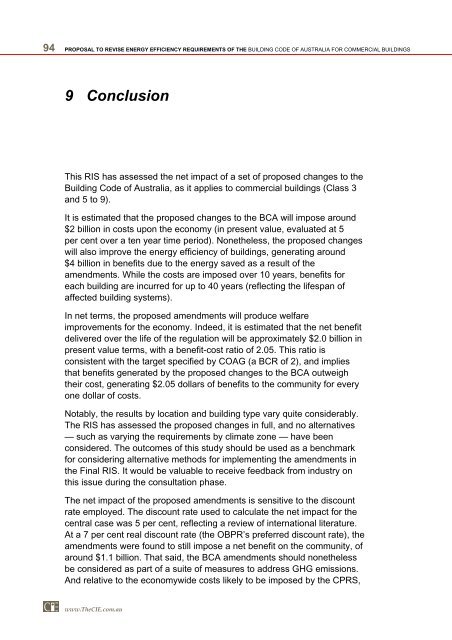PDF | 2 MB - Australian Building Codes Board
PDF | 2 MB - Australian Building Codes Board
PDF | 2 MB - Australian Building Codes Board
You also want an ePaper? Increase the reach of your titles
YUMPU automatically turns print PDFs into web optimized ePapers that Google loves.
94 PROPOSAL TO REVISE ENERGY EFFICIENCY REQUIREMENTS OF THE BUILDING CODE OF AUSTRALIA FOR COMMERCIAL BUILDINGS<br />
9 Conclusion <br />
This RIS has assessed the net impact of a set of proposed changes to the<br />
<strong>Building</strong> Code of Australia, as it applies to commercial buildings (Class 3<br />
and 5 to 9).<br />
It is estimated that the proposed changes to the BCA will impose around<br />
$2 billion in costs upon the economy (in present value, evaluated at 5<br />
per cent over a ten year time period). Nonetheless, the proposed changes<br />
will also improve the energy efficiency of buildings, generating around<br />
$4 billion in benefits due to the energy saved as a result of the<br />
amendments. While the costs are imposed over 10 years, benefits for<br />
each building are incurred for up to 40 years (reflecting the lifespan of<br />
affected building systems).<br />
In net terms, the proposed amendments will produce welfare<br />
improvements for the economy. Indeed, it is estimated that the net benefit<br />
delivered over the life of the regulation will be approximately $2.0 billion in<br />
present value terms, with a benefit-cost ratio of 2.05. This ratio is<br />
consistent with the target specified by COAG (a BCR of 2), and implies<br />
that benefits generated by the proposed changes to the BCA outweigh<br />
their cost, generating $2.05 dollars of benefits to the community for every<br />
one dollar of costs.<br />
Notably, the results by location and building type vary quite considerably.<br />
The RIS has assessed the proposed changes in full, and no alternatives<br />
— such as varying the requirements by climate zone — have been<br />
considered. The outcomes of this study should be used as a benchmark<br />
for considering alternative methods for implementing the amendments in<br />
the Final RIS. It would be valuable to receive feedback from industry on<br />
this issue during the consultation phase.<br />
The net impact of the proposed amendments is sensitive to the discount<br />
rate employed. The discount rate used to calculate the net impact for the<br />
central case was 5 per cent, reflecting a review of international literature.<br />
At a 7 per cent real discount rate (the OBPR’s preferred discount rate), the<br />
amendments were found to still impose a net benefit on the community, of<br />
around $1.1 billion. That said, the BCA amendments should nonetheless<br />
be considered as part of a suite of measures to address GHG emissions.<br />
And relative to the economywide costs likely to be imposed by the CPRS,<br />
www.TheCIE.com.au
















